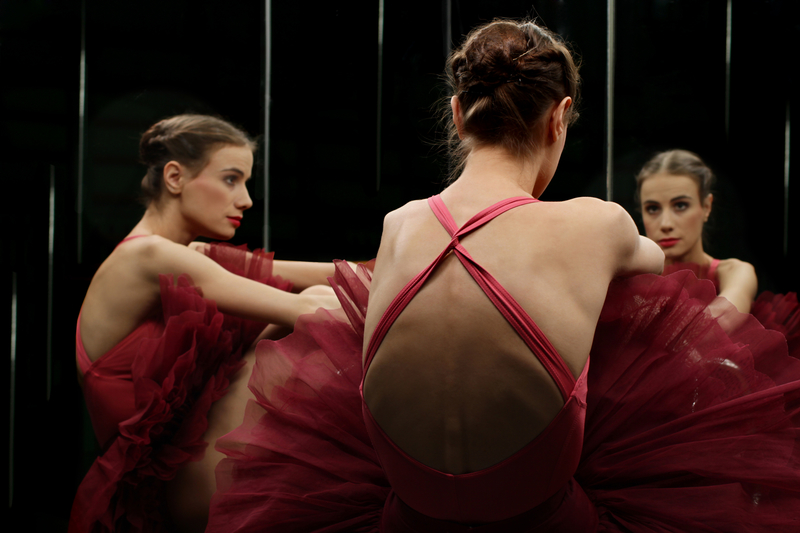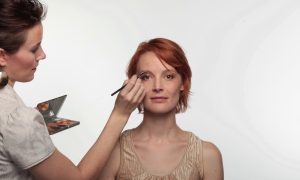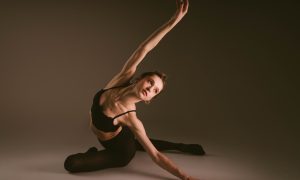For some time now, I have been aware of my own love-hate relationship with the dance studio mirror. I have used the mirror to check my own alignment, see where I should be in a formation and to manage the aesthetics of my performance. What I have noticed more, though, is my lack of internal body awareness when I rely on my reflection, not to mention the negative thoughts and judgments that flood my mind. This got me thinking…does the dance studio mirror act as more of a helper or hindrance? And, how can we best use the mirror to create mindful, healthy dancers?
The origins of the dance studio mirror are not well documented. It seems appropriate that a person would need a mirror to see their lines and alignment. I do remember as a younger dancer using the mirror to ensure I had correct spacing. I also recall the anxiety that came with the rehearsals leading up to tech week when we danced facing away from the mirror. The fear of relying on my own recall and not on what I saw others doing in the mirror definitely contributed to some initial stage fright and performance anxiety. But what toll does the mirror take on mental health and body awareness? Do we end up sacrificing our bodily-felt sensations, proprioception and kinesthetic awareness for a more pleasing reflection?
Positive aspects of mirror use for dancers include correcting placement, assessing lines and receiving immediate visual feedback. For dance instructors, it is helpful in seeing as many dancers in the room as possible. There are many negative aspects of mirror use, however. These include relying too heavily on what we see and not what we feel, fixating on body image not self expression, and potentially delaying or stunting development of other sensory systems needed for dancers to reach their full potential.
As a dance therapist, I do not typically use a mirror with my clients. Dance therapy is not about what is reflected but rather reflecting on our internal feelings and where we feel our emotions and thoughts. It is about connecting to ourselves and gaining a sense of understanding through felt sensations and mind-body awareness. But for some of my older adult clients living with dementia, the dance studio is not complete without a barre and mirrored wall. These elements often put seasoned dancers at ease and create a sense of familiarity and home providing a respite from symptoms of confusion or agitation. With my younger clients, clients who have a history of trauma or an issue around body image, the mirror becomes the enemy in the room reflecting their fears, imperfections and thoughts of self-loathing or criticism. To focus on the self, the mirror is covered. This sends the message that we are here to focus on our internal sensations and to reconnect to what is on the inside, rather than what we see or show others.
I have noticed that when I do not use a mirror, I am forced to rely on how something feels in my body. Not only does this allow for me to connect emotionally to the choreography, but it also allows for me to gauge what proper alignment and technique feels like in my body and, more importantly, when it feels off. I can determine where I am in space and involve other senses by not using visual input as a crutch.
This quote, taken from a resource paper entitled, Mirrors in the Dance Class: Help or Hindrance?, from the International Association for Dance Medicine and Science, put the implications of the mirror and body image into perspective.
“A dancer’s personal vision of her body is an important part of her psychological health and well-being, and it can help or hinder her dance performance in the studio. Heightened self-consciousness can sometimes cause a dancer to become overly critical of the way she looks. As a result, dance students frequently develop negative feelings about their bodies. This is a reality that many dance teachers understand from experience and witness on a daily basis. For instance, it is not uncommon for a dance teacher to observe a student standing in front of the mirror in a leotard with shrugged shoulders, looking down at the ground, seemingly feeling bad about herself.”
This may be an all too common occurrence, so how can we as dance educators and performers practice proper mirror etiquette?
- Encourage students to use other methods of learning that help develop necessary skills for fullest potential. Incorporate imagery, creative movement, authentic movement and body awareness exercises.
- Use the mirror sparingly and reframe the importance of the mirror.
- Challenge students to perform without the mirror.
- Lastly, pay attention to how dependent students are on the mirror and how their demeanor and mood is influenced by the mirror’s presence.
It is important to note that there are many differing opinions on whether the mirror is more helpful or hindering. What I believe to be the most valuable tool when it comes to deciding which side of the fence you are on is each individual dancer’s connection to the mirror. Get to know your dancers. As educators, it is our responsibility to foster positive mental health while developing strong technical dancers. Use your own discretion, and explore different ways to assist your students in becoming the best dancers they can be. After all, their technical training and skills are a reflection of you, the educator, and that is something no mirror can teach.
For more literature on how the mirror may be affecting your students, check out the article above in its entirety here.
 By Erica Hornthal, LCPC, BC-DMT, Dance/Movement Therapist, Chicago Dance Therapy.
By Erica Hornthal, LCPC, BC-DMT, Dance/Movement Therapist, Chicago Dance Therapy.
Erica Hornthal is a licensed professional clinical counselor and board certified dance/movement therapist based in Chicago, IL. She received her MA in Dance/Movement Therapy and Counseling from Columbia College Chicago and her BS in Psychology from the University of Illinois Champaign-Urbana. Erica is the founder and CEO of Chicago Dance Therapy, the premier dance therapy and counseling practice in Chicago, IL. As a body-centered psychotherapist, Erica assists clients of all ages and abilities in harnessing the power of the mind-body connection to create greater awareness and understanding of emotional and mental health. For more, visit www.chicagodancetherapy.com.















